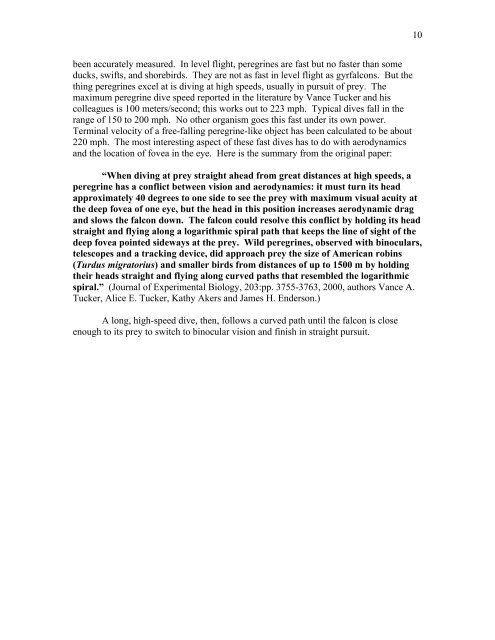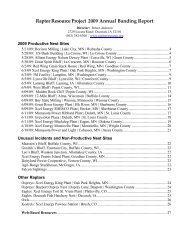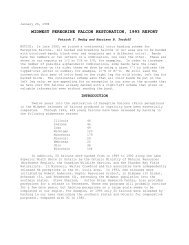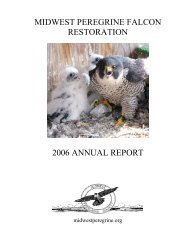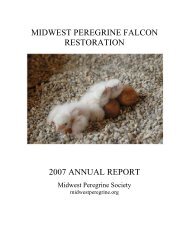2002 - Midwest Peregrine Falcon Restoration Project
2002 - Midwest Peregrine Falcon Restoration Project
2002 - Midwest Peregrine Falcon Restoration Project
Create successful ePaper yourself
Turn your PDF publications into a flip-book with our unique Google optimized e-Paper software.
10<br />
been accurately measured. In level flight, peregrines are fast but no faster than some<br />
ducks, swifts, and shorebirds. They are not as fast in level flight as gyrfalcons. But the<br />
thing peregrines excel at is diving at high speeds, usually in pursuit of prey. The<br />
maximum peregrine dive speed reported in the literature by Vance Tucker and his<br />
colleagues is 100 meters/second; this works out to 223 mph. Typical dives fall in the<br />
range of 150 to 200 mph. No other organism goes this fast under its own power.<br />
Terminal velocity of a free-falling peregrine-like object has been calculated to be about<br />
220 mph. The most interesting aspect of these fast dives has to do with aerodynamics<br />
and the location of fovea in the eye. Here is the summary from the original paper:<br />
“When diving at prey straight ahead from great distances at high speeds, a<br />
peregrine has a conflict between vision and aerodynamics: it must turn its head<br />
approximately 40 degrees to one side to see the prey with maximum visual acuity at<br />
the deep fovea of one eye, but the head in this position increases aerodynamic drag<br />
and slows the falcon down. The falcon could resolve this conflict by holding its head<br />
straight and flying along a logarithmic spiral path that keeps the line of sight of the<br />
deep fovea pointed sideways at the prey. Wild peregrines, observed with binoculars,<br />
telescopes and a tracking device, did approach prey the size of American robins<br />
(Turdus migratorius) and smaller birds from distances of up to 1500 m by holding<br />
their heads straight and flying along curved paths that resembled the logarithmic<br />
spiral.” (Journal of Experimental Biology, 203:pp. 3755-3763, 2000, authors Vance A.<br />
Tucker, Alice E. Tucker, Kathy Akers and James H. Enderson.)<br />
A long, high-speed dive, then, follows a curved path until the falcon is close<br />
enough to its prey to switch to binocular vision and finish in straight pursuit.


